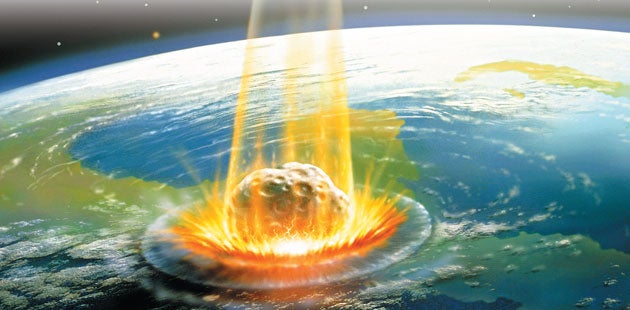Wipe-out: how a terrible asteroid impact wiped out the dinosaurs
65.5 million years ago

So what happened to the non-avian dinosaurs? The rocks speak clearly for themselves: after dinosaurs had dominated life on land for more than 160 million years, from about 65.5 million years ago another mass extinction occurred and all traces of dinosaur fossils disappear completely.
It wasn't just the dinosaurs that were wiped out. The last of the pterosaurs, the flying reptiles, also vanished, as did all the sea reptiles except for the turtles which somehow survived. It was also the end of the road for the ammonites, those bizarre spiral-shaped fossils, relations of today's octopus and squid ( see Part 1).
Life on Earth survives inside a thin, delicate layer of atmospheric skin on top of a lump of hard, lifeless rock. That's exactly how it would have looked to the six-mile-wide asteroid hurtling towards Earth 65.5 million years ago at a speed of some 70,000mph. Far in the distance, a bright blue-green dot would have been gradually growing larger and larger by the day. As the dark chunk of deadly rock and ice made its final approach, planet Earth would have resembled a sparkling bright jewel in a void, black sea of space.
Freakish misfortune powered it on its lethal journey and when the end came it was as colossal as it was spectacular. Not that the Earth isn't used to the occasional googly bowled by chance from outer space. Asteroids, meteorites, comets – they all fall from the skies in a constant rain. Usually they vapourise as they cut through the dense atmosphere, burning up with the shock of suddenly encountering the Earth's thick, heavy air.
But not when they are this big. Down it came, possibly splitting up into several pieces before finally making its rendezvous with an unsuspecting world. At the point of biggest impact, just at the edge of the Yucatá*Peninsula in Mexico, the asteroid would have blasted a crater more than a hundred miles wide, destroying in seconds everything within a 600-mile radius. The force would have been equivalent to thousands of nuclear bombs exploding all at once, vapourising anything and everything into nothing more than a cloud of deathly, blisteringly hot, toxic gas.
Outside the immediate impact zone, where everything evaporated in an instant, the Earth convulsed. Gigantic tidal waves hundreds of feet high spilled from shore to shore. The destruction these tsunamis caused on both land and sea would have been awesome. Weeks passed before the seas calmed once again. Worse luck came from the fact that the rocks directly under the impact zone were rich in sulphur, a highly toxic substance. The impact spread poisonous sulphur dust all around the world, adding yet another dimension to the devastation for everything that breathed the air.
The noise and sight of the impact would have deafened and blinded countless living creatures. Many of those not killed by the blast would have been drowned by the waves. For perhaps as long as a year the Earth, enveloped by heavy, acrid clouds, was without light from the sun.
Subscribe to Independent Premium to bookmark this article
Want to bookmark your favourite articles and stories to read or reference later? Start your Independent Premium subscription today.

Join our commenting forum
Join thought-provoking conversations, follow other Independent readers and see their replies